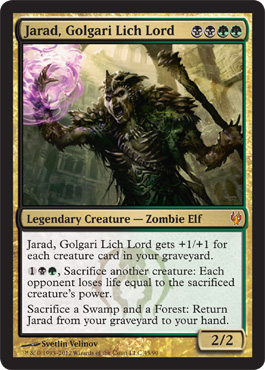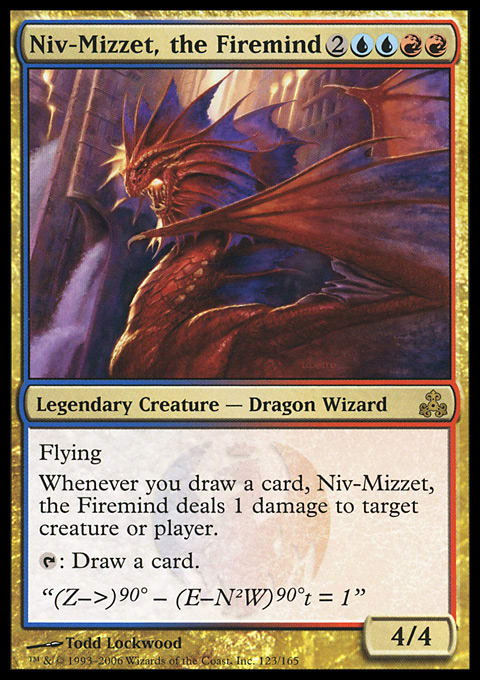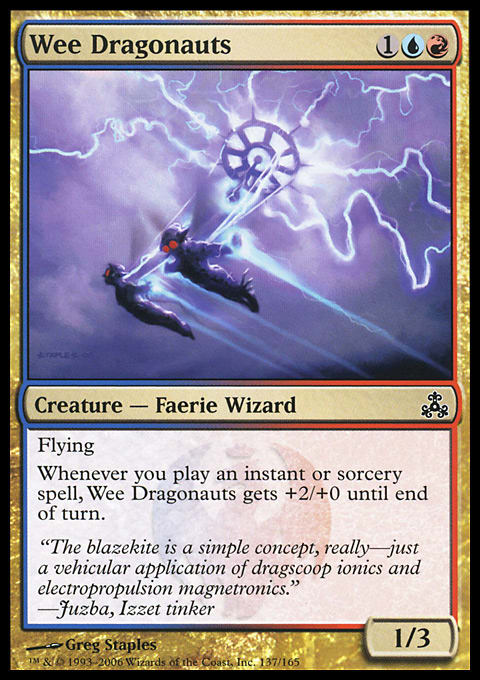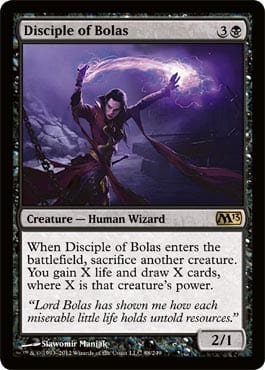With Duel Decks: Izzet v. Golgari, we got to see Jarad, Golgari Lich Lord. And what a card:

Duel Decks purchasers I know tend to keep the decks together, making modifications from their collections or swapping parts with another purchaser. (Two players in my group swapped entire decks of Duel Decks: Garruk vs. Liliana so that one player had all the Garruk and the other all the Liliana.) Since I want to explore building with Jarad, it seems fun to build a souped-up set of decks before the lists are spoiled. I hope Wizards doesn’t reveal the lists in between my submission and the publication of this article, but if so, this is my attempt to improve on whatever they did. Yeah . . . that’s what I’ll claim.
The Rules of Duels
Depending on accent and emphasis, that heading could rhyme. Anyway, since this exercise is in a kind of awkward spot by working with a new build-around card in the form of Jarad and an old build-around card in the form of Niv-Mizzet, I set a couple guidelines in making these decks:- My decks should look like the person building them had money for two sets of the decks, whether that’s buying the decks and funding changes or buying two decks and mashing the best parts together. To that end, the rarity distribution should be similar to existing Duel Decks, but it’s okay to double up on rares. Also, this maxes each deck out at two of its legend.
- For a dash of flavor and a nod to my assumption that most Duel Decks purchasers have started playing since Ravnica: City of Guilds and have collections starting since then, I’m only building with cards made since Ravnica. This is different than being printed since Ravnica—I’m not accepting reprints, even as Browbeat would be some fun with Niv-Mizzet. (I had a build that wanted to drop Niv-Mizzet and some other random creatures and then play Manabarbs to slay in a flurry of 1-damage jabs. It would have been awkward but fun.)
- None of my rares should come from Ravnica block. This is a 2012 product, and card choices should reflect that. Besides, guild leaders taking the best rare spells of their own guilds isn’t that interesting. I’ll take uncommons and commons from Ravnica block, though; there are not only a lot of cards fueling strategies in the respective colors, but there are also the bounce lands, which are a necessity given Niv-Mizzet’s and Jarad’s color-intensive mana costs.
- As duel decks, they should be tuned to fight each other. I didn’t test these decks, but I made many choices with the opposing deck in mind.
With those rules in place, here are the decks and discussions.
"Niv-Mizzet’s Drawing Class"
- Creatures (21)
- 3 Azure Mage
- 3 Impaler Shrike
- 3 Izzet Guildmage
- 3 Sturmgeist
- 4 Wee Dragonauts
- 3 Psychosis Crawler
- 2 Niv-Mizzet, the Firemind
- Spells (14)
- 2 Magma Spray
- 2 Release the Ants
- 3 Sage's Dousing
- 2 Devastating Summons
- 2 Distortion Strike
- 3 Arc Trail
- Lands (25)
- 12 Island
- 7 Mountain
- 2 Reliquary Tower
- 4 Izzet Boilerworks
Niv-Mizzet’s deck wants to keep cards flowing, both for its rare creatures and for its removal suite. It can run the quick game off Wee Dragonauts, using removal to keep tempo and eliminate blockers, or it can use Arc Trail and Sage's Dousing to buy time for Sturmgeist, Psychosis Crawler, or Niv-Mizzet. If going on the defensive, it might have to use Azure Mage and Impaler Shrike as blockers, but as 2/1s and 3/1s, they can trade up.
When Niv-Mizzet’s out, there are a number of ways to make sure he finishes quickly. Azure Mage, Impaler Shrike, Sturmgeist, and Sage's Dousing (there are thirteen Wizards in the deck) can draw cards, while Psychosis Crawler is Niv-Mizzet’s virtual Furnace of Rath.
The instants and sorceries apart from Sage's Dousing were chosen for optimal interaction with Izzet Guildmage. Distortion Strike is cast twice, once from the hand and the other from exile, so it’s double the value with Wee Dragonauts’s trigger while giving the Guildmage more chances to copy it. Arc Trail has a lot of targets in Jarad’s deck as it is, but copying it could let you kill an x/4 or just several x/1s. Magma Spray’s in over Pillar of Flame because being instant lets it aid your chump-blockers as well as enable surprise Wee Dragonauts blocks; the exile clause was necessary given Jarad’s recursion antics (it’s hard to find cards in U/R to interact fairly with graveyards, so I’m very curious to see what the real deck has). Release the Ants when copied lets you clash multiple times; the copy resolves first, so you can use the copy’s clash to up the odds that the card goes back to your hand. The deck has a clash edge over Jarad’s cheap stuff, so it should work a fair bit.
Devastating Summons is probably the oddest inclusion on initial inspection, particularly for a duel deck, but it does a few things this deck needs. Jarad’s deck doesn’t have a lot of removal, but it does have several more creatures plus the ability to make Demons with Skirsdag High Priest. Devastating Summons is a way to generate large creatures to match Jarad, Svogthos, the Restless Tomb, and Ghoultree in the late game as well as a way to turn excess lands into multiple creatures. Should Izzet Guildmage copy Devastating Summons, you’re looking at a major army, and all it takes is a Distortion Strike and a couple turns to swing a win out of a tough situation. Niv-Mizzet as a card is built so much on plink-plonk advantages that the deck needed something big and swingy to deal with Jarad’s bombs. Devastating Summons fits the bill while adding that dollop of chaos the Izzet’s famous for. (“Izzet Bar and Grill – Home of the Chaos!”)
And it’s not as though the deck minds having cards stuck in the hand after sacrificing lands. The deck can draw into more lands in the first place, but if it doesn’t, all those cards in hand make Sturmgeist and Psychosis Crawler bigger. As long as the board presence is there before the Summons, the deck shouldn’t need many more lands.
"Jarad’s Life Models"
- Creatures (30)
- 2 Ghoultree
- 2 Golgari Thug
- 2 Skirsdag High Priest
- 2 Viscera Dragger
- 3 Disciple of Bolas
- 3 Golgari Guildmage
- 3 Putrid Leech
- 3 Thornweald Archer
- 4 Fa'adiyah Seer
- 4 Shambling Shell
- 2 Jarad, Golgari Lich Lord
- Spells (5)
- 3 Putrefy
- 2 Revive the Fallen
- Lands (25)
- 10 Swamp
- 9 Forest
- 2 Svogthos, the Restless Tomb
- 4 Golgari Rot Farm
It’s as hard to make a fair, interactive, casual, graveyard-recursion deck as it is to find cards to oppose at the same level, but this deck should strike a balance between utility creatures fiddling and humongous beatsticks. I like both, and I especially like when the former sets up the latter.
Apart from Ghoultree, Jarad’s curve tops out with himself, Disciple of Bolas, and Viscera Dragger. That might make twenty-five lands seem odd, but two are copies of Svogthos, the Restless Tomb, used to maximum effect here as extra finishers. Golgari Guildmage is mana-intensive and therefore a card I rarely include anywhere, but with a sleek curve, it should work nicely, particularly as its +1/+1 counter ability complements Shambling Shell for putting a deck of x/1s and x/2s out of burn range. The old pump-versus-burn-stacking subgames would show up aplenty with these decks.
Putrid Leech is around for early beatdown—beatdown the Izzet deck can’t deal with easily apart from instant burn. The Leech has a secondary function of curving smoothly into Disciple of Bolas, as drawing four cards off your 2/2 on turn four is nice even if you have to trade a little life for it. Shambling Shell, besides its enabling the deck’s dredge side, is good friends with the Disciple as well. Golgari Thug’s a finicky dredger, but there’s plenty of value on all the modes, whether playing the occasional ground defense, being an early pseudo-evasive creature—since there’s little point in blocking it—or just as a thing to sacrifice.
Viscera Dragger might seem off, but that’s because, in most decks, it’s meant primarily to cycle and unearth. Here, unearth is a minority option, and cycling takes prominence, whether that cycling is just to enable dredge instead of drawing the card, to make Ghoultree cost cheaper in the near future, or to pump Jarad and Svogthos at instant speed. Since Jarad’s deck has more creatures than Niv-Mizzet’s, an unearthed Viscera Dragger might deal the final blow by swinging hastily as that one creature in excess of the blockers—especially if Jarad’s around to sacrifice it afterward for an extra 3 life.
Thornweald Archer is a concession to all the Izzet flying and as a target for that decks’ removal. Sometimes, it will be right for Niv-Mizzet to point Magma Spray at Thornweald Archer so Wee Dragonauts can push through, and that resource tension is key to making Duel Decks work. Fa'adiyah Seer is among my favorite dredgers. With twenty-five lands, it can find you your mana, but it also can read, “![]() : Dredge,” with no drawbacks, and that’s about as weirdly fun as it comes at common.
: Dredge,” with no drawbacks, and that’s about as weirdly fun as it comes at common.
There’re a lot of small creatures, but they fuel the deck in several ways. Just having more creatures than the other side is sometimes enough to lay some early beats for Jarad to come in and finish, and it’s not as though Jarad minds them dying. Jarad and Svogthos live off such creatures dying, Ghoultree is not only a beater, but an out-of-nowhere win condition with Jarad on the battlefield, as a Ghoultree in hand and seven creatures in the graveyard make Jarad read, “
Putrefy made more sense when Niv-Mizzet’s deck had Staff of Nin, but it’s unconditional removal and, given their chase-uncommon status, a reasonable value inclusion the way Swords to Plowshares showed up in Elspeth’s Duel Decks deck. Revive the Fallen won’t win as many clashes as Release the Ants, but it doesn’t need to; it just needs to get some of the recursion chains going again, and if it returns to the hand, so much the better.
Conclusion
You don’t need me to tell you that Niv-Mizzet and Jarad can do all manner of absurd things. I hope making interactive, interesting decks around them in anticipation of the decklists gives you some ideas for initial modifications if you by the decks, but it also should give a window into Duel Decks design if you’re into that sort of thing. Both decks will get some help from Return to Ravnica, but until then, it’s fun to whet the appetite for guilded goodness.































